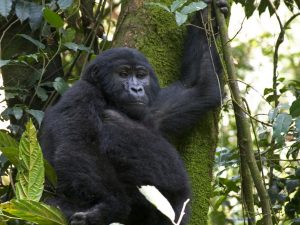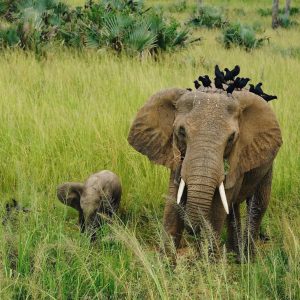Facts about Mountain Gorillas
Mountain gorillas are one of the most iconic and endangered primate species on Earth. They inhabit the dense tropical forests of Bwindi Impenetrable Forest and Mgahinga Gorilla National Park in southwestern Uganda. These remote, mountainous areas provide a rich, high-altitude ecosystem with thick vegetation, creating an ideal natural habitat for these elusive great apes. Interesting facts about mountain Gorillas
Bwindi Impenetrable Forest
alone is home to over half of the world’s remaining population of mountain gorillas, making it one of the most significant conservation areas for this species. The forest’s steep, mist-shrouded slopes and tangled undergrowth offer both protection and sustenance, allowing gorilla families to forage and move relatively undisturbed. Mgahinga Gorilla National Park, though smaller, also contributes to Uganda’s conservation success and is part of the larger Virunga ecosystem.
Outside Uganda
mountain gorillas can also be found in Volcanoes National Park in Rwanda and Virunga National Park in the Democratic Republic of Congo. These three parks together form the Virunga Massif, a transboundary conservation area that spans across the borders of the three countries. The Massif provides continuous forest cover and diverse terrain that supports gorilla movement and interbreeding between groups, which is vital for genetic diversity.
This tri-national region is critical not only for gorilla survival but also for broader biodiversity conservation. Thanks to international cooperation, strong protection efforts, and sustainable tourism practices, mountain gorilla numbers have steadily increased in recent decades. Although they remain endangered, the recovery of the mountain gorilla population stands as one of the world’s most remarkable conservation achievements
For decades, mountain gorillas faced the threat of extinction due to widespread poaching, habitat destruction, civil unrest, and disease. These great apes were once hunted and killed at alarming rates, and their forest homes were rapidly disappearing due to human activity. By the 1980s, their population had dwindled to a dangerously low number, raising global alarm for urgent conservation action.
Thanks to coordinated and sustained efforts by governments, conservation organizations, and local communities, mountain gorillas have been pulled back from the brink. The introduction of regulated gorilla tourism, strict anti-poaching laws, veterinary care, and community-based conservation programs has made a significant impact. Revenue from responsible tourism has supported not only gorilla protection but also local development projects, fostering a sense of ownership and stewardship among communities living near the parks.
Population
Today, the population of mountain gorillas is steadily rising—a rare conservation success story for a critically endangered species. This progress demonstrates the power of collaborative conservation and the positive role that ecotourism can play in protecting wildlife. While challenges remain, the survival of the mountain gorilla is now more hopeful than ever before.
Listed below are the Facts Mountain Gorillas
Why are they called mountain Gorillas?
The mountain gorillas are the largest primates that live in the dense tropical forests, they live at an elevation ranging from 1,500 to 4,000 metres in altitude. The temperature tends to drop below the freezing point making the place extremely cold up in Bwindi impenetrable forest, Virunga, volcanoes national park. the gorillas have thick fur covering their skin which helps to regulate the temperatures. There is over 1,063 according to the latest figure of the world’s population of the mountain gorillas in the Virunga massif that is Uganda, DRC and Rwanda.
Mountain Gorillas are wanderers
Mountain gorillas do not have a stable home, they are wanderers they live in the wild and each day they move from one location to another to build their nests, they have a territory ,they make their beds with twigs, leaves, branches, they cover small kilometers each day to set up a new home. But they can also migrate from one country to another like they can move from Uganda to Rwanda or to the Democratic Republic of Congo or vice versa. This is a reason why travellers trek the mountain the gorillas because they move each day and you will need to move some distance to locate them.
Trekkers will raise up early morning and head to the park headquarters for briefing and they will be divided in groups led by the rangers/ Guides in to the forest for the start of Gorilla trekking. Gorilla trekking depends on the particular gorilla family you have been assigned to trek and only a group of 8 people are allowed to trek each gorilla family per day.
Mountain Gorillas are the Gentle Giants of the Forest
Mountain gorillas are naturally peaceful and gentle primates that spend most of their time foraging, grooming, and resting in the forest. However, like many wild animals, they can become aggressive if they feel threatened or startled. In situations where they perceive danger, a dominant silverback may react with defensive behavior to protect his family group.
When disturbed, a mountain gorilla might display signs of agitation such as chest-thumping, loud grunting, roaring, or mock charging. These actions are not immediate signs of an attack but are meant to serve as a warning. This bluffing behavior is a way for the silverback to assert dominance and deter any perceived threat without resorting to actual violence.
Most of the time, if you remain calm and follow the guidelines provided by your guide or ranger—such as avoiding direct eye contact, crouching down, and not making sudden movements—the gorilla will de-escalate the situation. These defensive displays highlight the gorilla’s strong protective instincts and emphasize why respectful behavior and professional guidance are essential when trekking in their natural habitat.
In case the gorilla’s charges, you can respond by crouching down and lowering your head to show that you have accepted defeat. The gorillas are strong and huge creatures, the silverback is the head of the family and will defend the family at any cause. The male gorilla/silver back is Ten times stronger than the Adult human.
Mountain gorillas communicate with one another
The fact that the mountain gorillas are almost have the total DNA of 98% like the humans, they have a higher larynx compared to humans and a soft palate which does not make them to communicate with verbs, nouns or make sentences like the humans do. They simply grunt, hoot, make gestures, chest beating, and making symbols which is there way of communication. As a result of gorilla habituation, this has facilitated the communication and the interaction of the gorillas with the humans using the sign language.
The Gorilla Doctors make forest Calls which Keeps the Gorillas Healthy:
Mountain gorillas, though massive and huge, they are not fat:
Mountain gorillas, like many intelligent primates, have demonstrated the ability to use tools to simplify their daily activities. While not as commonly observed as in chimpanzees, tool use among gorillas is real and has been documented in the wild, particularly in their natural habitats such as Bwindi Impenetrable Forest and the Virunga Massif.
Gorillas often learn tool use through observation and social learning, especially from older group members. This transfer of knowledge highlights their cognitive abilities and social structure. For instance, gorillas have been seen using sticks to extract ants from tree crevices or from the ground—an act that requires patience and precision. By doing so, they avoid being bitten while accessing a protein-rich food source.
In some observed behaviors, gorillas have used branches or logs as bridges to cross streams, demonstrating an understanding of how to manipulate their environment to overcome obstacles. Others have been witnessed removing snares from their group members, particularly young gorillas, showing both intelligence and empathy. These actions indicate not only tool use but also problem-solving and protective behavior within their social groups. Interesting facts about mountain Gorillas
As research and observation continue, scientists anticipate discovering even more ways in which mountain gorillas use tools to make their lives easier. These discoveries shed light on the complex cognitive world of gorillas and further highlight the importance of conserving their habitats. Protecting these forests ensures we continue learning from these incredible creatures while securing their future in the wild. Interesting facts about mountain Gorillas
The silver coat on a silverback Mountain Gorilla shows a sign of Maturity like a lion’s Mane:
The young male gorilla has black-backed fur. As he grows and reaches sexual maturity, he begins to develop a saddle-shaped area of silver hair on his back. This transformation, much like human beards or lion manes, signals that he has matured. It also indicates that he is ready to assume the role of the family’s leader and take responsibility for protecting and guiding its members. Interesting facts about mountain Gorillas




